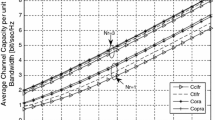Abstract
Space-time block codes (STBCs) are known to orthogonalize the multiple input multiple out (MIMO) wireless channels. In this paper, we study the capacity of STBCs over Weibull MIMO channels under three adaptive transmission techniques: optimal power and rate adaptation, optimal rate adaptation with constant transmit power and channel inversion with fixed rate, and obtain closed-form expressions for the corresponding capacity. This capacity provides an upper bound on spectral efficiency using these techniques and avoids Monte Carlo simulations. Moreover, we also examine the effects of the fading severity on the concerned quantities. The figures show that our theoretical results of channel capacity line up exactly with the simulations.
Similar content being viewed by others
References
Sulyman A. I., Ibnkahla M. (2008) Performance of MIMO systems with antenna selection over nonlinear cading channels. IEEE Journal of Selected Topics in Signal Processing 2: 159–170
Ma Y., Zhao L. (2007) Achievable performance of orthogonal STBC over spatially correlated rician channels. IEEE Transactions on Vehicular Technology 56: 1251–1261
Sezgin A., Jorswieck E.A., Henkel O. et al (2008) On the relation of OSTBC and code rate one QSTBC: average rate, BER, and coding gain. IEEE Transactions on Signal Processing 56: 4879–4891
Chen C.Y., Sezgin A., Cioffi J.M. et al (2008) Antenna selection in Space–time block coded systems: Performance analysis and low-complexity algorithm. IEEE Transactions on Signal Processing 56: 3303–3314
Musavian L., Nakhai M. R. (2007) On the capacity of orthogonalised correlated MIMO channels under different adaptive transmission techniques. IET Communications 1: 464–471
Kwan R., Leung C. (2007) General order selection combining for Nakagami and Weibull fading channels. IEEE Transactions on Wireless Communications 6: 2027–2032
Sagias N. C., Zogas D. A., Karagiannidis G. K., Tombras G. S. (2004) Channel capacity and second-order statistics in Weibull fading. IEEE Communications Letters 8: 377–379
Kwan R., Leung C. (2007) On the applicability of the pearson method for approximating distributions in wireless communications. IEEE Transactions on Communications 55: 2065–2069
Da Costa D.B., Yacoub M.D., Fraidenraich G. et al (2007) General exact level crossing rate and average fade duration for dual-diversity combining of nonidentical correlated weibull signals. IEEE Transactions on Vehicular Technology 56: 3571–3577
Zhang H., Gulliver T. A. (2005) Capacity and error probability analysis for orthogonal Space–time block codes over fading channels. IEEE Transactions on Wireless Communications 4: 808–819
Zhou Z. d., Vucetic B., Dohler M., Yonghui Li (2005) MIMO systems with adaptive modulation. IEEE Transactions on Vehicular Technology 54: 1828–1842
Alouini M. S., Goldsmith A. J. (1999) Capacity of Rayleigh fading channels under different adaptive transmission and diversity-combining techniques. IEEE Transactions on Vehicular Technology 48: 1165–1181
Gradshteyn I. S., Ryzhik I. M. (1994) Table of integrals, series, and products (5th ed.). Academic Press, New York
Adamchik, V. S., & Marichev, O. I. (1990). The algorithm for calculating integrals of hypergeometric type functions and its realization in REDUCE system. In Proceedings of internataional conference on symbolic and algebraic computation (pp. 212–224), Tokyo.
Forenza A., McKay M.R., Pandharipande A. et al (2007) Adaptive MIMO transmission for exploiting the capacity of spatially correlated channels. IEEE Transactions on Vehicular Technology 56: 619–630
Mallik R.K., Win M.Z., Shao J.W. et al (2004) Channel capacity of adaptive transmission with maximal ratio combining in correlated Rayleigh fading. IEEE Transactions on Wireless Communications 3: 1124–1133
Maaref A., Aissa S. (2005) Capacity of Space–time block codes in MIMO Rayleigh fading channels with adaptive transmission and estimation errors. IEEE Transactions on Wireless Communications 4: 2568–2578
Author information
Authors and Affiliations
Corresponding author
Rights and permissions
About this article
Cite this article
Xiao, HL., Ouyang, S., Nie, ZP. et al. Capacity of Orthogonalized Weibull MIMO Channels Under Different Adaptive Transmission Techniques. Wireless Pers Commun 55, 539–550 (2010). https://doi.org/10.1007/s11277-009-9814-0
Received:
Accepted:
Published:
Issue Date:
DOI: https://doi.org/10.1007/s11277-009-9814-0




